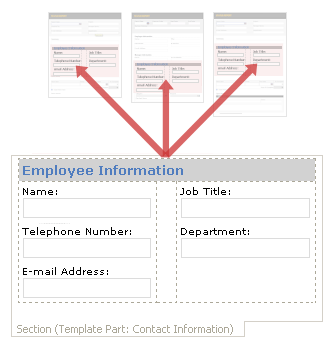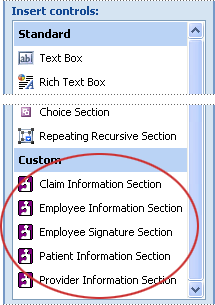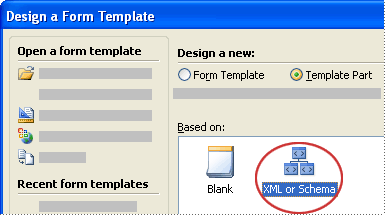Scenarios for using template parts
This article provides scenarios for using template parts in your own form templates. Although you may have different business needs than the human resource and sales-based needs described in this article, you can apply the underlying scenario principles to your own situation.
Note: This article does not describe how to design and distribute template parts. Find links to more information about the design and distribution of template parts in the See Also section.
In this article
Benefits of using template parts
Template parts are reusable portions of a form template. They typically include controls, a data source, and features such as data connections or data validation. Template parts can be useful in many situations. However, they are particularly beneficial when you have large numbers of form templates that contain common controls and design components. Instead of redesigning a standard section in individual form templates, you can design just one template part and reuse it in multiple form templates.
The following image shows a single Employee Information template part, which is reused in different business forms throughout an organization.

There is much to be gained by standardizing form sections, so that all form designers are using identical template parts. By using template parts, you can make it easier to:
-
Design form templates If you offer form designers a library of template parts, they can reuse common design elements in a variety of form templates. By using a library of template parts, form designers can save time because they do not have to design the same sections for each individual form. For example, many business forms contain a series of text boxes for an employee name, job title, e-mail address, and other relevant contact information. You can design this section once, using a template part, add data validation or other business logic features to the specific controls, and then distribute the template part to form designers. After the form designers add the template part to the Controls task pane, they can reuse the Contact Information section wherever they need to, and they don't need to redesign the Contact Information section each time that they need to use it.
-
Fill out forms Consistency is good for the people who fill out forms, too. It helps them complete forms more quickly, because no matter which form the user is working with, common fields use the same labeling, are organized consistently, and respond to data input in an expected way.
-
Reuse form data Standardization is critical if form data is submitted to corporate-wide systems, such as Customer Relationship Management (CRM) databases, which require consistent field names and data types. By using template parts, you can help ensure that the data in identical sections of a form adheres to a common model for data exchange.
Scenario 1: Human resources
The human resources (HR) department for a large insurance agency is responsible for designing and maintaining a series of form templates that are related to recruiting and staffing, providing benefits, paying employees, and ensuring compliance to regulations. Because many of these form templates share common sections, such as employee information and employee signature sections, it makes sense for HR department personnel to work with developers in the information technology (IT) department to develop a library of commonly used template parts. Form designers within the company can access this library of template parts from the Controls task pane.

As an example, for healthcare reimbursement forms, employees in a human resources department may determine that the following template parts are necessary.
| Template part | Possible fields | Used in |
| Logo header | None | Most forms |
| Employee information section | Employee first, middle, and last name; Date of birth; Mailing address; Home telephone number; Office telephone number; Job title; Department name | Most forms |
| Employee information section | Employee first, middle, and last name; Mailing address; Plan ID number; Group number | Medical claim forms |
| Patient information section | Patient first, middle, and last name; Date of birth; Mailing address; Gender; Relationship to employee | Medical claim forms |
| Provider information section | Provider first, middle, and last name; Mailing address; Telephone number | Medical claim forms |
| Claim information section | Date of service; Total payment submitted | Medical claim forms |
| Employee signature section | Employee signature; Date | Medical claim forms |
| Employee ID section | Employee ID; Employee first, middle, and last name; E-mail address, Telephone number; Hire date; Job ID; Salary; commission; manager; department | Medical claim forms |
Scenario 2: Sales
The sales department for a pharmaceutical company plans to design a series of InfoPath form templates that will be used to collect information about product orders and customers. The company currently uses an XML Schema to help standardize the collection of business data. This schema is used primarily by the marketing, sales, and customer service departments, and it defines the data that is related to customers, products, and orders.
In InfoPath, form designers can create template parts that are based on existing schemas by selecting the XML or Schema option in the Design a Form Template dialog box.

Once the form designer has created the template part, they can insert controls on the template part that are bound to appropriate fields from the schema. Designers can specify data validation settings, rules, calculated default values, and data connections for controls on the template part. When they've finished designing the template part, they can save it and announce its availability to other form designers in the organization, who can then use the template part in their own form templates.
As an example, employees in the sales department may determine that the following template parts are necessary.
| Template part | Possible fields | Used in |
| Customer section | Customer ID; Customer name; Customer type; Mailing address; City; State/province; ZIP/Postal Code; Country/region; E-mail address; Telephone number | Customer interaction forms; information request forms; order forms; call tracking forms; demo request; service request |
| Order header | Department; Distribution center; Sales organization | Customer interaction forms; information request forms; order forms; call tracking forms; demo request; service request |
| Order status section | Order date; Ship date; E-mail address | Order forms; invoice forms |
| Delivery status section | Patient name; Relationship to employee; Birth date | Order forms; invoice forms |
| Payment information section | Payment type; Payment date; Payment notes | Order forms; invoice forms |
| Order details section | Product ID; Quantity; Unit cost; Date received; Discount; Total price; Status | Order forms; invoice forms |
| Shipping address section | Shipping name; Shipping address; City; State/province; ZIP/Postal Code; Country/region | Order forms; invoice forms |
| Billing address section | Billing name; Billing address; City; State/province; ZIP/Postal Code; Country/region | Order forms; invoice forms |
| Sales agent section | Agent name; Start date; End date; Job department | Order forms; invoice forms |
| Commission section | Sales organization; Sales person; Commission quantity; Commission amount; Order amount; Order quantity; Percent quantity | Order forms; invoice forms |
No comments:
Post a Comment